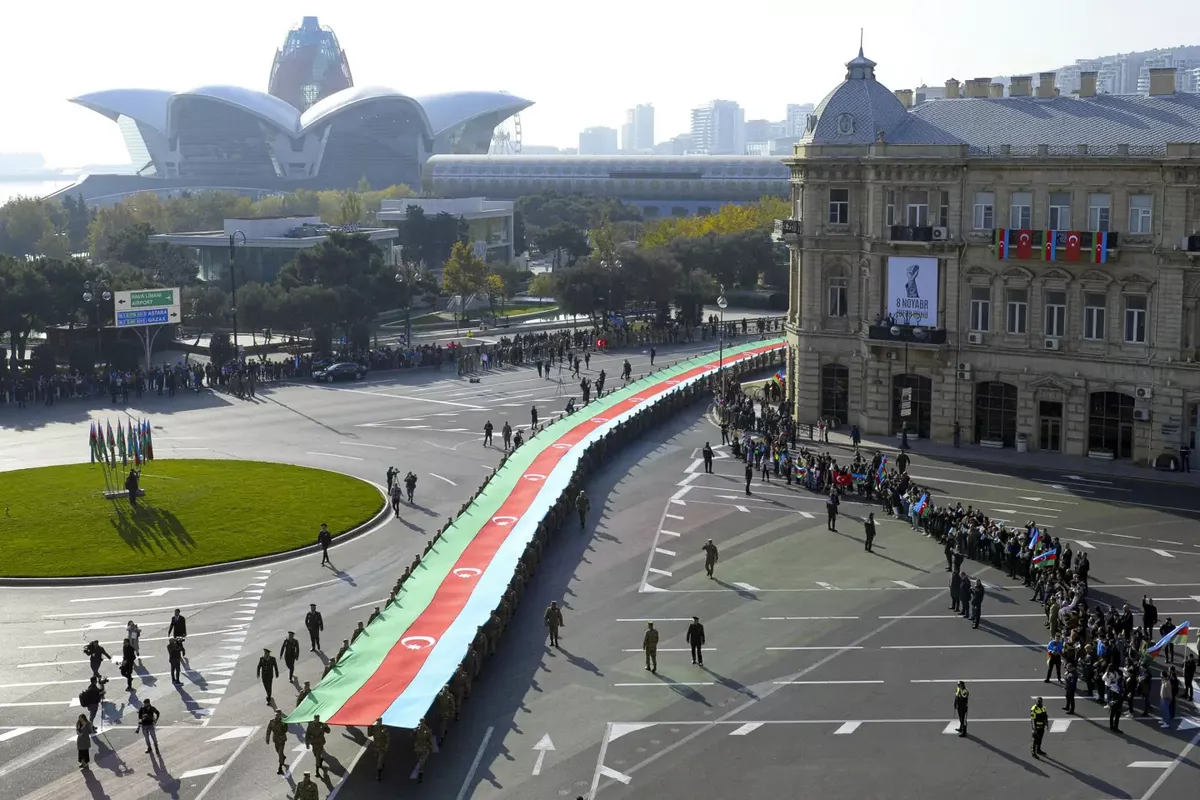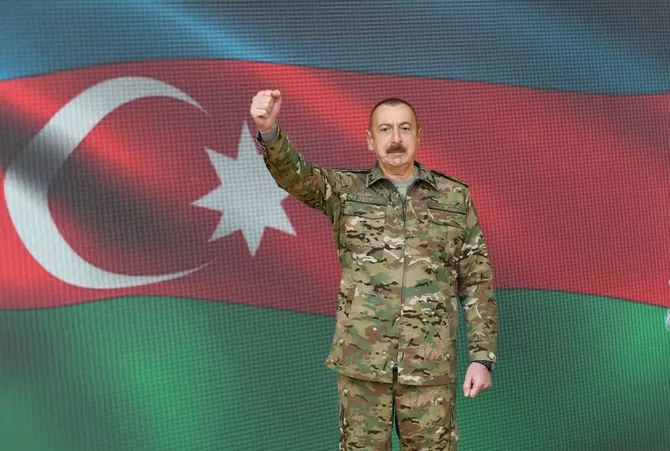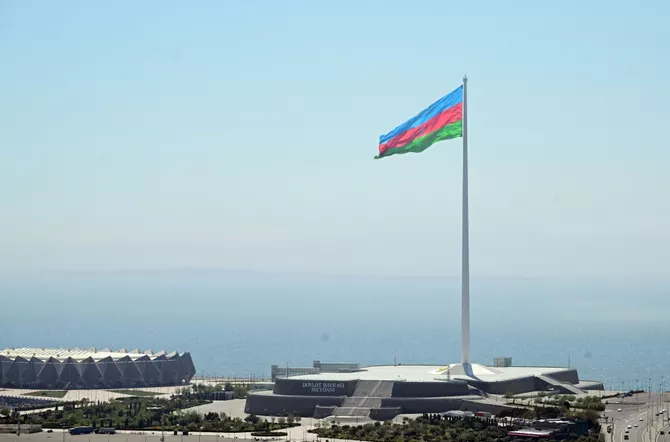
Photo: AP
Five years ago, the 44-day war between Azerbaijan and Armenia fundamentally changed the geopolitical landscape of the South Caucasus. The liberation of Shusha on November 8, 2020, marked the defining moment of the conflict.
For Azerbaijanis, the city symbolized cultural revival and the restoration of historical justice. The following day, a trilateral statement signed by Azerbaijan, Armenia, and Russia formally ended the hostilities and set the stage for a new political and security order in the region.
The war’s outcome not only restored Azerbaijan’s territorial integrity but also reshaped its political identity. The sense of national unity forged during those weeks remains a core pillar of Azerbaijan’s domestic consensus and foreign policy orientation. The return of control over previously occupied lands was seen not as conquest but as the culmination of a decades-long process of state consolidation and modernization that began after independence in 1991.

Photo: AZERTAC
Strategic restraint and calculated leadership
One of the most notable aspects of Azerbaijan’s campaign was the decision to halt military operations after achieving its principal objectives. Despite having a clear military advantage, Baku refrained from advancing beyond its internationally recognized borders. This decision reflected not weakness but strategic foresight.
As revealed in comments by U.S. Special Envoy Steven Witkoff, U.S. President Donald Trump once questioned President Ilham Aliyev about this choice. Aliyev’s response - that Azerbaijan sought only the return of what was rightfully its own - illustrates a pragmatic understanding of power and legitimacy. Such restraint transformed a potential regional escalation into an internationally recognized victory.
This approach also shielded Azerbaijan from possible diplomatic backlash and underscored its commitment to the UN Charter and the principles of international law. By framing its actions as lawful self-defense, Baku managed to shift the global discourse: the war was no longer perceived as a clash between two small states but as a precedent for restoring sovereignty through limited, precision-based military action.

Photo: AzTV
Reshaping regional power balances
The 44-day conflict marked a decisive redistribution of influence in the South Caucasus. For nearly three decades, Armenia had relied on a combination of military presence and external backing to maintain control over occupied Azerbaijani territories. That strategy collapsed under the weight of the technological and organizational superiority demonstrated by the Azerbaijani Armed Forces.
The war introduced a new phase in regional geopolitics. Azerbaijan emerged as a medium power capable of setting the regional agenda, while Armenia entered a prolonged period of internal transformation and strategic re-evaluation.
The outcome also revealed the limits of external actors’ influence: none of the major powers - Russia, the United States, or France - could prevent the shift once the dynamics on the ground had changed.
The conflict further solidified Türkiye’s role as a regional partner. Its military and political support for Azerbaijan deepened bilateral relations, leading to the signing of the 2021 Shusha Declaration, which elevated the partnership to the level of an alliance. This synergy now extends beyond defense to include energy cooperation, transport integration, and joint participation in trans-Eurasian initiatives such as the Middle Corridor.
Russia, meanwhile, positioned itself as a mediator and peacekeeping force. Its contingent deployed in Karabakh after the ceasefire symbolized both Moscow’s residual leverage and the evolving multipolar nature of the post-war order.
However, as new actors, particularly the European Union, China, and Central Asian states, begin to engage more actively in the region, Russia’s ability to dominate the narrative has gradually declined.

Photo: AZERTAC
The reconstruction agenda
Following the end of hostilities, Azerbaijan embarked on an ambitious reconstruction campaign in the liberated territories. Entire towns and villages destroyed during decades of occupation are being rebuilt under a state-led program of “smart cities” and “green energy zones.” Infrastructure projects, including new airports in Fuzuli and Zangilan and the restoration of road and rail links, are transforming the region into a new logistical hub between the Caspian and the Black Seas.
Shusha, declared the “Cultural Capital of Azerbaijan,” stands at the center of this revival. The restoration of its historic monuments, mosques, and theaters has become both a symbol of national pride and a diplomatic showcase of post-conflict renewal. These efforts also carry a broader message: the liberation of territories is inseparable from the responsibility to rebuild and reintegrate them.
The peace process and regional diplomacy
Parallel to reconstruction, Azerbaijan has pursued a policy of normalization with Armenia. President Aliyev has repeatedly stated Baku’s readiness to sign a comprehensive peace treaty based on mutual recognition of territorial integrity and sovereignty. This position is consistent with international law and reflects a desire to translate victory into long-term regional stability.
The peace process has been complex, shaped by lingering mistrust, domestic political constraints in Yerevan, and competing geopolitical influences. Nevertheless, negotiations facilitated by the European Union and other international actors have led to a gradual convergence on fundamental principles. The reopening of transport routes, particularly the prospective Zangezur corridor linking mainland Azerbaijan with Nakhchivan, remains a central element of Baku’s postwar vision.
If implemented, this corridor could redefine trade and transit across Eurasia, connecting the South Caucasus directly to Central Asia and further east to China. It would also symbolize the shift from confrontation to cooperation, transforming former dividing lines into routes of integration.
Information warfare and global perception
In contrast to earlier decades of narrative competition, the 2020 war unfolded in an era of digital transparency. Real-time satellite imagery, drone footage, and open-source intelligence limited the effectiveness of misinformation. Allegations of systemic abuses were not substantiated, while Azerbaijan emphasized compliance with humanitarian law.
Many international observers acknowledged the relatively disciplined nature of the Azerbaijani campaign, which avoided strikes beyond the country’s borders and minimized civilian harm. This approach reinforced the perception of a modern, technologically advanced military guided by clear strategic directives rather than emotion or vengeance.
The information dimension of the war also revealed a shift in international attitudes. Whereas previous narratives often cast Azerbaijan as the challenger to a fragile status quo, post-2020 discourse increasingly recognizes it as the legitimate enforcer of international norms and sovereignty.
Five years later: Stability, challenges, and new ambitions
Five years after the war, the South Caucasus is entering a new phase of stability. The ceasefire has largely held, and Azerbaijan has transitioned from wartime mobilization to peacetime consolidation. The country’s foreign policy now combines regional pragmatism with global outreach: from strengthening ties with Central Asia and the Gulf states to expanding cooperation with the European Union and China.
At the same time, new challenges have emerged. Reintegrating the liberated territories requires not only physical reconstruction but also social and demographic renewal. Ensuring the safe return of internally displaced persons, restoring multiethnic coexistence, and preventing the re-emergence of radicalism remain long-term priorities.
For Armenia, the postwar years have been characterized by domestic polarization and a reassessment of national strategy. The defeat in 2020 eroded public trust in traditional security partners and sparked debate over the country’s future direction - whether to pursue renewed cooperation with its neighbors or continue relying on distant allies.

Photo: AZERTAC
Azerbaijan’s emerging role in the wider region
The legacy of 2020 extends beyond the borders of the South Caucasus. Azerbaijan’s success in combining military efficiency with diplomatic balance has made it a model for states seeking to resolve protracted conflicts through the limited, lawful use of force.
The country’s growing engagement in energy security, logistics, and digital connectivity projects positions it as a bridge between Europe and Asia at a time of global realignment.
Baku’s ability to maintain constructive relations with diverse partners-including Türkiye, Russia, the EU, and China-illustrates its flexible foreign policy strategy. This multi-vector approach enhances Azerbaijan’s leverage while protecting it from overdependence on any single bloc. The country’s expanding role in the Organization of Turkic States and its participation in global climate diplomacy, exemplified by hosting COP29 in 2024, further demonstrate its broader ambitions.
Conclusion: From Victory to Vision
The Second Karabakh War did not merely restore territorial integrity; it redefined Azerbaijan’s place in the international system. The events of 2020 marked the end of an era of frozen conflict and the beginning of a period of dynamic regional transformation.
Five years on, Azerbaijan stands as a state that has turned military success into diplomatic capital and national revival into a platform for regional cooperation. Its experience shows that post-conflict recovery can be achieved through a combination of pragmatism, planning, and international engagement.
The road ahead remains complex, but the trajectory is clear: the South Caucasus is moving from the legacy of division toward a framework of connectivity and shared prosperity. In that sense, the legacy of November 2020 lies not only in the liberation of Shusha but in the emergence of a new vision for peace and integration in the heart of Eurasia.
By Tural Heybatov
Share on social media